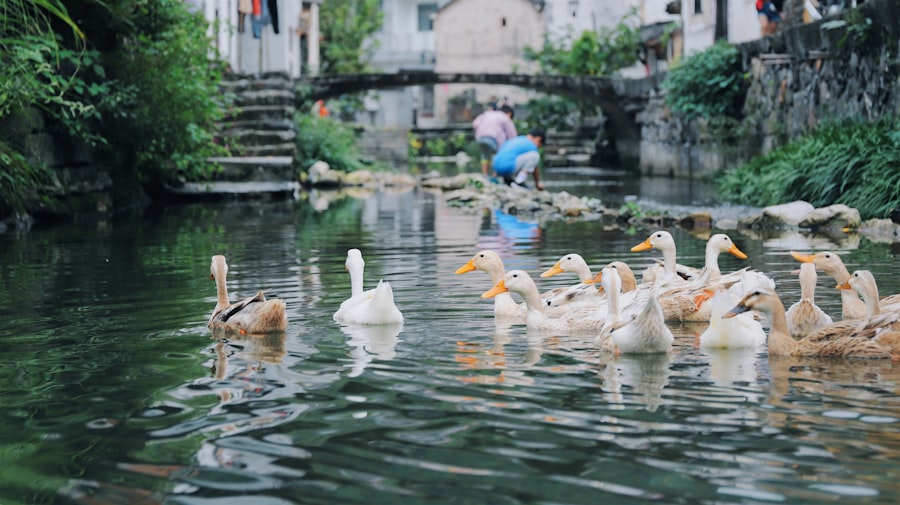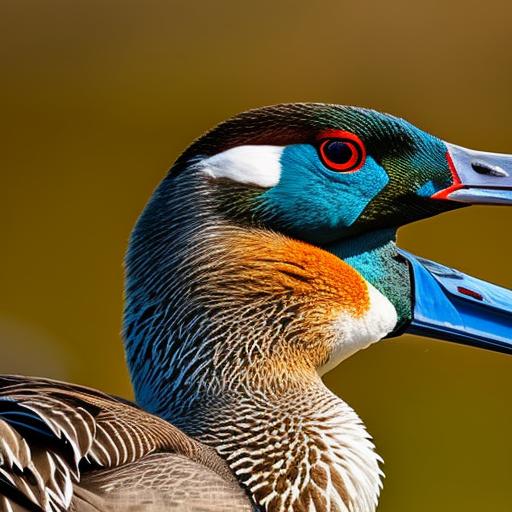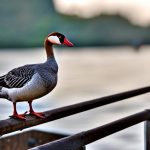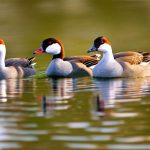Keeping geese clean and healthy is of utmost importance for geese owners. Geese hygiene plays a crucial role in their overall well-being and can have a significant impact on their health. Maintaining good hygiene practices ensures that geese are protected from diseases, infections, and other health issues. In this article, we will explore the importance of keeping geese clean, understand the impact of poor hygiene on geese health, identify common sources of dirt and contamination in geese, learn how to properly clean and disinfect geese housing, maintain clean drinking water for geese, practice bathing and grooming techniques for geese, manage feather health and prevent feather mites, address health issues caused by poor hygiene practices, and prevent foul odors and pest infestations in geese.
Key Takeaways
- Geese hygiene is important for their health and well-being.
- Common sources of dirt and contamination in geese include feces, feathers, and bedding.
- Proper cleaning and disinfection of geese housing is crucial to prevent the spread of disease.
- Clean drinking water is essential for geese to maintain good health.
- Regular bathing and grooming can help prevent feather mites and maintain feather health.
Understanding the Importance of Keeping Geese Clean
Maintaining good hygiene practices is essential for the health and well-being of geese. Poor hygiene can lead to various health issues such as infections, diseases, and parasites. Geese are susceptible to a range of diseases, including avian influenza, salmonellosis, and botulism. These diseases can be transmitted through contaminated water, food, or surfaces. By keeping geese clean and their environment free from dirt and contamination, the risk of these diseases can be significantly reduced.
In addition to preventing diseases, maintaining good hygiene practices also promotes overall health in geese. Cleanliness helps to keep their feathers in good condition, which is important for insulation and protection against the elements. It also reduces the risk of skin irritations and infections. Furthermore, clean living conditions contribute to the overall well-being of geese by providing them with a comfortable and stress-free environment.
Identifying Common Sources of Dirt and Contamination in Geese
There are several common sources of dirt and contamination in geese that need to be identified and prevented. One of the main sources is their own feces. Geese produce a significant amount of droppings, which can quickly accumulate and create an unsanitary environment. These droppings can contain harmful bacteria and parasites that can cause diseases.
Another common source of dirt and contamination is dirty water sources. Geese require clean drinking water to stay hydrated and healthy. If their water sources are contaminated with feces, dirt, or other debris, it can lead to the ingestion of harmful bacteria and parasites.
Geese housing can also be a source of dirt and contamination if not properly cleaned and maintained. Accumulated droppings, feathers, and dirt can create an ideal breeding ground for bacteria, fungi, and pests. It is important to regularly clean and disinfect geese housing to prevent the spread of diseases and maintain a clean living environment for the geese.
How to Properly Clean and Disinfect Geese Housing
Cleaning and disinfecting geese housing is an essential part of maintaining good hygiene practices. Here is a step-by-step guide on how to properly clean and disinfect geese housing:
1. Remove geese from the housing: Before starting the cleaning process, make sure to remove the geese from their housing and place them in a safe and secure area.
2. Remove all bedding material: Start by removing all bedding material from the housing. This includes straw, hay, or any other material used as bedding. Dispose of the used bedding properly.
3. Sweep or vacuum the floor: Use a broom or vacuum cleaner to remove any loose dirt, feathers, or droppings from the floor of the housing.
4. Scrub the surfaces: Use a scrub brush or sponge with warm water and a mild detergent to scrub all surfaces of the housing, including walls, floors, and nesting areas. Pay special attention to areas where droppings may have accumulated.
5. Rinse with clean water: After scrubbing, rinse all surfaces with clean water to remove any remaining detergent or dirt.
6. Disinfect the housing: Once the surfaces are clean, use a disinfectant recommended for use in poultry housing to disinfect all areas. Follow the instructions on the disinfectant product for proper dilution and application.
7. Allow for proper drying: After disinfection, allow the housing to air dry completely before reintroducing the geese.
It is important to note that regular cleaning and disinfection should be done on a routine basis to maintain good hygiene in geese housing.
Maintaining Clean Drinking Water for Geese
Clean drinking water is essential for the health and well-being of geese. Here are some tips for maintaining clean water sources for geese:
1. Provide fresh water daily: Geese should have access to fresh, clean water at all times. Make sure to provide them with a clean water source every day.
2. Clean water containers regularly: Water containers should be cleaned and refilled regularly to prevent the buildup of dirt, algae, or bacteria. Scrub the containers with a brush and rinse thoroughly before refilling.
3. Use clean water sources: Avoid using stagnant or dirty water sources for geese. If using natural water sources such as ponds or streams, make sure they are clean and free from contamination.
4. Prevent fecal contamination: Ensure that geese cannot defecate directly into their water containers. Elevated or covered water containers can help prevent fecal contamination.
5. Monitor water quality: Regularly check the quality of the water by observing its clarity and smell. If the water appears dirty or has a foul odor, it may be contaminated and should be replaced immediately.
By following these tips, geese owners can ensure that their birds have access to clean drinking water, reducing the risk of diseases and promoting good health.
Bathing and Grooming Techniques for Geese

Bathing and grooming are important aspects of geese hygiene. Here are some recommended techniques for bathing and grooming geese:
1. Provide a shallow pool or tub: Geese enjoy bathing in water, so providing them with a shallow pool or tub can help keep them clean. The water should be deep enough for the geese to submerge their bodies but not too deep that they struggle to stay afloat.
2. Use clean water: Make sure the water used for bathing is clean and free from contaminants. Change the water regularly to prevent the buildup of dirt or bacteria.
3. Monitor bathing behavior: Some geese may not naturally take to bathing, so it may be necessary to encourage them by gently guiding them into the water or splashing water on their feathers. Observe their behavior and adjust accordingly.
4. Groom feathers: Regularly inspect the feathers of geese for any signs of damage, parasites, or dirt. Remove any loose feathers or debris by gently plucking them out. This helps to maintain healthy feathers and prevent feather mites.
5. Provide dust baths: In addition to water baths, geese also enjoy dust baths. Provide a designated area with loose soil or sand where they can roll around and clean their feathers.
By incorporating these bathing and grooming techniques into their routine, geese owners can help keep their birds clean and maintain healthy feathers.
Managing Feather Health and Preventing Feather Mites
Feather health is crucial for geese as it provides insulation, protection, and helps with flight. Here are some tips for managing feather health and preventing feather mites:
1. Provide a balanced diet: A balanced diet rich in essential nutrients is important for maintaining healthy feathers in geese. Make sure they have access to a variety of foods that provide the necessary vitamins and minerals.
2. Regularly inspect feathers: Regularly inspect the feathers of geese for any signs of damage, parasites, or dirt. Look for broken or missing feathers, signs of feather mites, or excessive dirt buildup.
3. Remove loose feathers: Remove any loose or damaged feathers by gently plucking them out. This helps to maintain healthy feather growth and prevents the spread of feather mites.
4. Dust baths: Provide a designated area with loose soil or sand where geese can take dust baths. Dust baths help to remove excess oil and dirt from feathers and can help prevent feather mites.
5. Treat feather mites: If feather mites are detected, it is important to treat them promptly. Consult with a veterinarian for appropriate treatment options and follow their recommendations.
By managing feather health and preventing feather mites, geese owners can ensure that their birds have healthy and well-maintained feathers.
Addressing Health Issues Caused by Poor Hygiene Practices
Poor hygiene practices can lead to various health issues in geese. Here are some common health issues caused by poor hygiene practices and how to address and prevent them:
1. Bacterial infections: Poor hygiene can lead to bacterial infections in geese, such as salmonellosis or E. coli infections. These infections can cause diarrhea, lethargy, loss of appetite, and other symptoms. To address bacterial infections, consult with a veterinarian for appropriate treatment options and follow their recommendations. Prevent bacterial infections by maintaining clean living conditions and providing clean water sources.
2. Fungal infections: Fungal infections can occur in geese if their living environment is damp or dirty. These infections can cause skin irritations, feather loss, and respiratory issues. To address fungal infections, consult with a veterinarian for appropriate treatment options and follow their recommendations. Prevent fungal infections by keeping geese housing clean and dry.
3. Parasite infestations: Poor hygiene practices can lead to parasite infestations in geese, such as feather mites or lice. These parasites can cause itching, feather damage, and overall discomfort for the geese. To address parasite infestations, consult with a veterinarian for appropriate treatment options and follow their recommendations. Prevent parasite infestations by regularly inspecting geese for signs of parasites and maintaining good hygiene practices.
By addressing and preventing health issues caused by poor hygiene practices, geese owners can ensure the well-being and longevity of their birds.
Tips for Preventing Foul Odors and Pest Infestations in Geese
Foul odors and pest infestations can be common problems in geese housing if proper hygiene practices are not followed. Here are some tips for preventing foul odors and pest infestations:
1. Regularly clean geese housing: Regularly clean and disinfect geese housing to prevent the buildup of droppings, feathers, and dirt. This helps to eliminate foul odors and reduce the risk of pest infestations.
2. Proper waste management: Dispose of geese droppings properly to prevent foul odors and attract pests. Consider composting or using the droppings as fertilizer in a controlled manner.
3. Maintain good ventilation: Proper ventilation in geese housing helps to reduce moisture levels and prevent the buildup of foul odors. Ensure that there is adequate airflow to keep the environment fresh.
4. Seal entry points: Inspect geese housing for any gaps or openings that pests can use to enter. Seal these entry points to prevent pest infestations.
5. Use pest control measures: If pest infestations occur, consult with a professional pest control service for appropriate measures to eliminate pests safely and effectively.
By following these tips, geese owners can prevent foul odors and pest infestations, creating a clean and healthy living environment for their birds.
Best Practices for Keeping Geese Clean and Healthy
In conclusion, maintaining good hygiene practices is crucial for keeping geese clean and healthy. By understanding the importance of keeping geese clean, identifying common sources of dirt and contamination, properly cleaning and disinfecting geese housing, maintaining clean drinking water, practicing bathing and grooming techniques, managing feather health, addressing health issues caused by poor hygiene practices, and preventing foul odors and pest infestations, geese owners can ensure the well-being of their birds. By following these best practices, geese can thrive in a clean and healthy environment, reducing the risk of diseases and promoting overall health.
If you’re looking for tips on how to keep geese clean, you might also be interested in learning about the benefits of using a snap-lock chicken coop. This innovative design from Poultry Wizard ensures that your chickens have a clean and secure living space, which can indirectly contribute to the cleanliness of your geese as well. To find out more about the snap-lock chicken coop and how it can improve the overall hygiene of your poultry, check out this informative article: https://poultrywizard.com/keeping-chickens/snaplock-chicken-coop/.
FAQs
What are some common ways geese get dirty?
Geese can get dirty from walking on muddy or wet ground, swimming in dirty water, or from their own droppings.
Why is it important to keep geese clean?
Keeping geese clean is important for their overall health and well-being. Dirty feathers can lead to skin irritation and infections, and dirty living conditions can lead to the spread of disease.
How often should I clean my geese?
It is recommended to clean your geese at least once a week, or more often if they are particularly dirty or if their living conditions are not ideal.
What is the best way to clean geese?
The best way to clean geese is to give them a bath in clean water. You can also use a gentle soap or shampoo specifically designed for birds. It is important to rinse them thoroughly and dry them off completely to prevent any skin irritation.
How can I prevent my geese from getting dirty?
You can prevent your geese from getting dirty by providing them with clean living conditions, such as a dry and well-drained area to walk and sleep in. You can also provide them with clean water to swim in and avoid feeding them in areas where they are likely to step in their own droppings.
Meet Walter, the feathered-friend fanatic of Florida! Nestled in the sunshine state, Walter struts through life with his feathered companions, clucking his way to happiness. With a coop that’s fancier than a five-star hotel, he’s the Don Juan of the chicken world. When he’s not teaching his hens to do the cha-cha, you’ll find him in a heated debate with his prized rooster, Sir Clucks-a-Lot. Walter’s poultry passion is no yolk; he’s the sunny-side-up guy you never knew you needed in your flock of friends!







